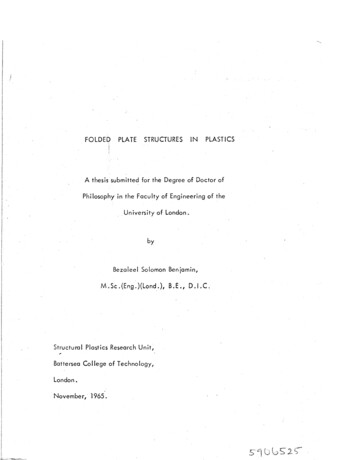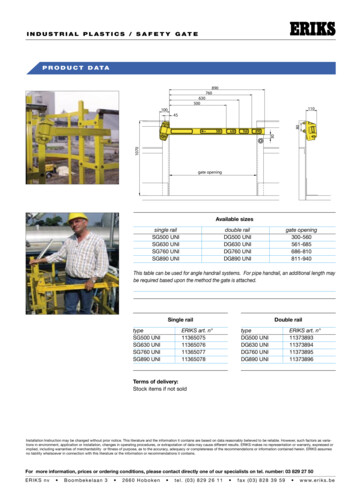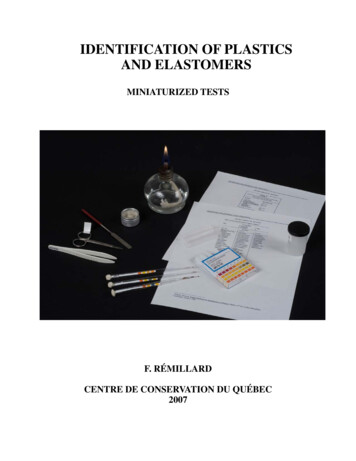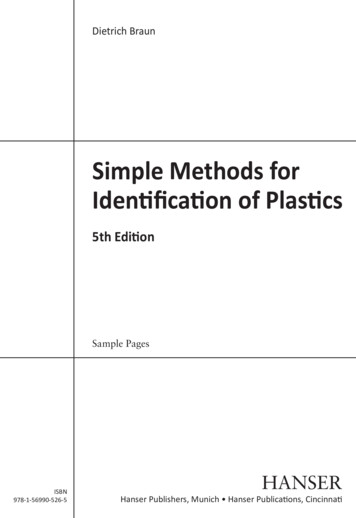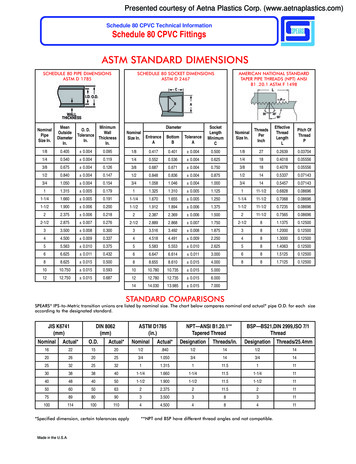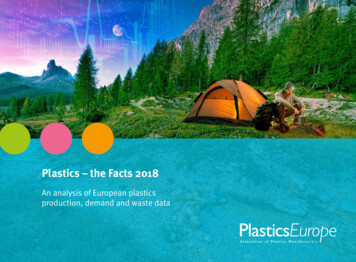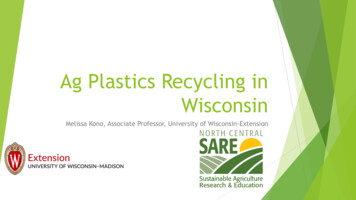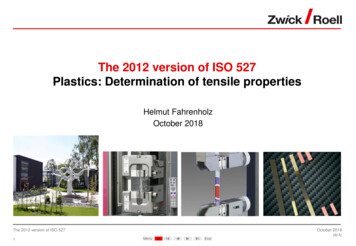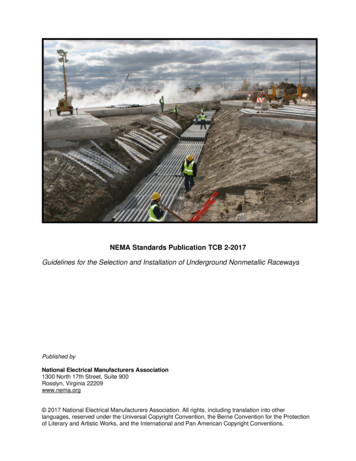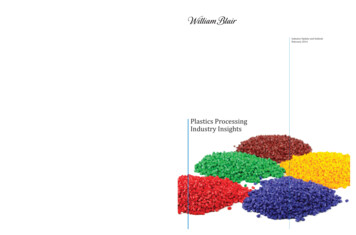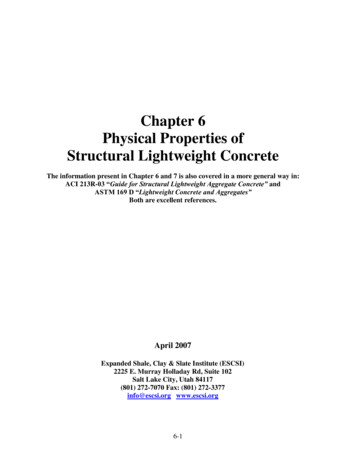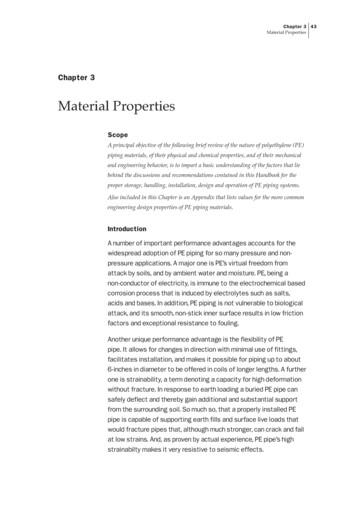
Transcription
Chapter 3 43Material PropertiesChapter 3Material PropertiesScopeA principal objective of the following brief review of the nature of polyethylene (PE)piping materials, of their physical and chemical properties, and of their mechanicaland engineering behavior, is to impart a basic understanding of the factors that liebehind the discussions and recommendations contained in this Handbook for theproper storage, handling, installation, design and operation of PE piping systems.Also included in this Chapter is an Appendix that lists values for the more commonengineering design properties of PE piping materials.IntroductionA number of important performance advantages accounts for thewidespread adoption of PE piping for so many pressure and nonpressure applications. A major one is PE’s virtual freedom fromattack by soils, and by ambient water and moisture. PE, being anon-conductor of electricity, is immune to the electrochemical basedcorrosion process that is induced by electrolytes such as salts,acids and bases. In addition, PE piping is not vulnerable to biologicalattack, and its smooth, non-stick inner surface results in low frictionfactors and exceptional resistance to fouling.Another unique performance advantage is the flexibility of PEpipe. It allows for changes in direction with minimal use of fittings,facilitates installation, and makes it possible for piping up to about6-inches in diameter to be offered in coils of longer lengths. A furtherone is strainability, a term denoting a capacity for high deformationwithout fracture. In response to earth loading a buried PE pipe cansafely deflect and thereby gain additional and substantial supportfrom the surrounding soil. So much so, that a properly installed PEpipe is capable of supporting earth fills and surface live loads thatwould fracture pipes that, although much stronger, can crack and failat low strains. And, as proven by actual experience, PE pipe’s highstrainabilty makes it very resistive to seismic effects.042-103.indd 431/16/09 9:50:41 AM
44Chapter 3Material PropertiesPE pipe and PE fittings can be joined to each other by thermalfusion processes which result in leak-proof bottle-tight joints thatare as strong and as tough as the pipe itself. These advantagescombine to make PE a preferred pipe for special applications,such as for horizontal directional drilling, for the renewal of oldpipes by insertion, and for marine outfalls. For the first two namedapplications the butt-fusion process – which avoids the use of largerdiameter couplings – enables installation to be conducted by pipepulling and it permits the use of a larger diameter pipe.Another recognized advantage of PE piping is its toughness. PEpipes, as well as the heat fusion joints in PE piping, greatly resistthe propagation of an initial small failure into a large crack – amajor reason for the overwhelming preference for PE piping forgas distribution applications. And, PE piping retains its toughnesseven at lower temperatures. In addition, PE piping exhibits very highfatigue resistance. Potential damage by repetitive variations inoperating pressure (surges) is highly resisted.Notwithstanding the above and various other advantages of PEpiping, its successful design and application requires adequaterecognition of its more complex stress/strain and stress/fracturebehavior. PE piping does not exhibit the simple proportionalitybetween stress and strain that is characteristic of metal pipes.And, its capacity to resist fracture is reduced as duration ofloading is increased. In addition, these and its other mechanicalproperties exhibit a greater sensitivity to temperature and certainenvironments. Furthermore, the specific mechanical responses bya PE pipe can vary somewhat depending on the PE material fromwhich it is made – mostly, depending on the nature of the PE polymer(e.g., its molecular weight, molecular weight distribution, degree ofbranching (density) but, also somewhat on the type and quantity ofadditives that are included in the piping composition. The particularbehavior of the PE pipe that is selected for an application must begiven adequate recognition for achieving an effective design andoptimum quality of service. A brief explanation of the engineeringbehavior of PE and the listing of its more important properties is amajor objective of this Chapter.042-103.indd 441/16/09 9:50:41 AM
Chapter 3 45Material PropertiesAn additional objective of this Chapter is the presentation of valuesfor the major properties that are used for material classification andpiping design, and a brief description of the methods based on whichthese properties are determined.PE PlasticsPlastics are solid materials that contain one or more polymeric substances which canbe shaped by flow. Polymers, the basic ingredient of plastics, compose a broad classof materials that include natural and synthetic polymers. Nearly all plastics are madefrom the latter. In commercial practice, polymers are frequently designated as resins.For example, a PE pipe compound consists of PE resin combined with colorants,stabilizers, anti-oxidants or other ingredients required to protect and enhanceproperties during fabrication and service.Plastics are divided into two basic groups, thermoplastics and thermosets, both ofwhich are used to produce plastic pipe.Thermoplastics include compositions of PE, polypropylene, and polyvinyl chloride(PVC). These can be re-melted upon the application of heat. The solid state ofthermoplastics is the result of physical forces that immobilize polymer chains andprevent them from slipping past each other. When heat is applied, these forcesweaken and allow the material to soften or melt. Upon cooling, the molecular chainsstop slipping and are held firmly against each other in the solid state. Thermoplasticscan be shaped during the molten phase of the resin and therefore can be extruded ormolded into a variety of shapes, such as pipe, pipe fittings, flanges or valves.Thermoset plastics are similar to thermoplastics prior to “curing,” a chemical reactionby which polymer chains are chemically bonded to each other by new cross-links.The curing is usually done during or right after the shaping of the final product.Cross-linking is the random bonding of molecules to each other to form a giant threedimensional network. Thermoset resins form a permanent insoluble and infusibleshape after the application of heat or a curing agent. They cannot be re-melted afterthey have been shaped and cured. This is the main difference between thermosetsand thermoplastics. As heat is applied to a thermoset part, degradation occurs at atemperature lower than the melting point. The properties of thermosetting resinsmake it possible to combine these materials with reinforcements to form strongcomposites. Fiberglass is the most popular reinforcement, and fiberglass-reinforcedpipe (FRP) is the most common form of thermoset-type pipe.042-103.indd 451/16/09 9:50:41 AM
to 600 F (93 to 316 C). The polyethylene that came from thesehigh pressure polyethylene'. It was produced in a free radical chaing ethylene gas under high pressure with peroxide or a trace amount of46Chapter 3Material Propertiescess was dangerousand expensive, so other safer and less expensiveHistory of PEloped. Polyethyleneproducedat inlowpressurewasintroducedin theThe Imperial ChemicalCompany (ICI)Englandfirst inventedPE in 1933.Theearly polymerizationprocessesused high-pressure(14,000 to 44,000psi) autoclave structuresds also affordedgreaterversatilityin tailoringmolecularreactors and temperatures of 200 to 600 F (93 to 316 C). The PE that came fromcatalysts, temperatures,andthese reactors was called“highpressures.pressure PE.” It was produced in a free radical chainreaction by combining ethylene gas under high pressure with peroxide or a traceamount of oxygen.olyethyleneThe original process was dangerous and expensive, so other safer and less expensiveprocesses were developed. PE produced at low pressure was introduced in the 1950’s.These methods also afforded greater versatility in tailoring molecular structuresthrough variations in catalysts, temperatures, and pressures.ge molecules formed by the polymerization (i.e. the chemical linking)olecular units. To produce polyethylene, the starting unit is ethylene, aManufacture of PEed of two double-bondedcarbon atoms and four hydrogen atoms (seePolymers are large molecules formed by the polymerization (i.e. the chemical linking)of repeating small molecular units. To produce PE, the starting unit is ethylene, acolorless gas composed of two double-bonded carbon atoms and four hydrogenatoms (see Figure 1).Figure 1 Manufacture of PEThere are currently three primary low-pressure methods for producing PE: gasphase, solution and slurry (liquid phase). The polymerization of ethylene may takeplace with various types of catalysts, under varying conditions of pressure andtemperature and in reactor systems of radically different design. Ethylene can also becopolymerized with small amounts of other monomers such as butene, propylene,hexene, and octene. This type of copolymerization results in small modifications intly three primary low pressure methods for producing polyethylene:and slurry (liquid phase). The polymerization of ethylene may takepes of catalysts, under varying conditions of pressure and temperaturems of radically different design. Ethylene can also be copolymerizedof other monomers such as butene, propylene, hexene, and octene. Thistion results in small modifications in chemical structure, which are042-103.indd 461/16/09 9:50:41 AM
Chapter 3 47Material Propertieschemical structure, which are reflected in certain differences in properties, such asdensity, ductility, hardness, etc. Resins that are produced without comonomer arecalled homopolymers.Regardless of process type, the chemical process is the same. Under reactionconditions, the double bond between the carbon atoms is broken, allowing a bondto form with another carbon atom as shown in Figure 1. Thus, a single chain of PE isformed. This process is repeated until the reaction is terminated and the chain lengthis fixed. PE is made by the linking of thousands of monomeric units of ethylene.Polymer CharacteristicsPE resins can be described by three basic characteristics that greatly influence theprocessing and end-use properties: density, molecular weight and molecular weightdistribution. The physical properties and processing characteristics of any PE resinrequire an understanding of the roles played by these three major parameters.DensityThe earliest production of PE was done using the high-pressure process whichresulted in a product that contained considerable “side branching.” Side branchingis the random bonding of short polymer chains to the main polymer chain. Sincebranched chains are unable to pack together very tightly, the resulting material had arelatively low density, which led to it being named low-density PE (LDPE).As time passed and PEs of different degrees of branching were produced, there wasa need for an industry standard that would classify the resin according to density.The American Society for Testing of Materials (ASTM) originally established thefollowing classification system. It is a part of ASTM D1248, Standard Specification forPolyethylene Plastics Molding and Extrusion Materials(2,5). This standard has sincebeen replaced by ASTM D 3350; ASTM D 1248 is no longer applicable to PE pipingmaterials.TypeDensityI0.910 - 0.925 (low)II0.926 - 0.940 (medium)III0.941 - 0.959 (high)IV0.960 and above (high, homopolymer)Type I is a low-density resin produced mainly in high-pressure processes. Alsocontained within this range are the linear-low-density polyethylenes (LLDPE), whichrepresent a recent development in the PE area using low-pressure processes.042-103.indd 471/16/09 9:50:41 AM
48 Chapter 3Material PropertiesType II is a medium density resin produced either by low- or high-pressure processes.Types III and IV are high-density polyethylenes. Type III materials are usuallywith a small amount of a comonomer (typically butene or hexene) thatis used to control chain branching. Controlled branching results in improvedperformancewhere certaintypesof arestressesaretoinvolved.Typeapplications wherecertain typesinofapplicationsstresses are involved.Type IVresinsreferredasIV resinsare referredto asonlywhichethyleneis usedhomopolymers sinceonly ethyleneis usedin homopolymersthe polymerizationsinceprocess,resultsin in theleast-branched andhighest-possible-densitymaterial.Figure3.2 depicts thepolymerizationprocess, whichresultsin lecular structuresassociatedwitheach typetheof variouspolyethylene.material.Figure2 depictsmolecular structures associated with each typeof PE.3-4 Engineering PropertiesproducedFigure 2 Chain Structure of PECrystallinityCrystallinityThe amount of side branching determines the density of the PE molecule. The moresidelower theThephenomenonthat occurs in PE canThe amount nsity ofthepackingpolyethylenemolecule. Thealso beterms ofThecrystallineversusnon-crystallineoramorphous regionsmore side branches,theexplainedlower theindensity.packing phenomenon that occurs inpolyethylene canas allineorillustrated in Figure 3. When molecules pack together in tight formation, theamorphous regionsas illustratedspacingin Figure3.3. When molecules pack together in tightintermolecularis reduced.formation, the intermolecular spacing is reduced.042-103.indd 481/16/09 9:50:41 AM
ng PropertiesChapter 3 49Material PropertiesFigure 3 Crystallinity in PEFigure 3.3. Crystallinity in PolyethylenePE is one of a number of polymers in which portions of the polymer chain in certainregions align themselves in closely packed and very well ordered arrangements ofpolyhedral-shaped, microscopic crystals called spherulites. Other
pipe is capable of supporting earth fills and surface live loads that would fracture pipes that, although much stronger, can crack and fail at low strains. And, as proven by actual experience, PE pipe’s high strainabilty makes it very resistive to seismic effects. 042-103.indd 43 1/16/09 9:50:41 AM. Chapter 3 Material Properties 44 PE pipe and PE fittings can be joined to each other by .

